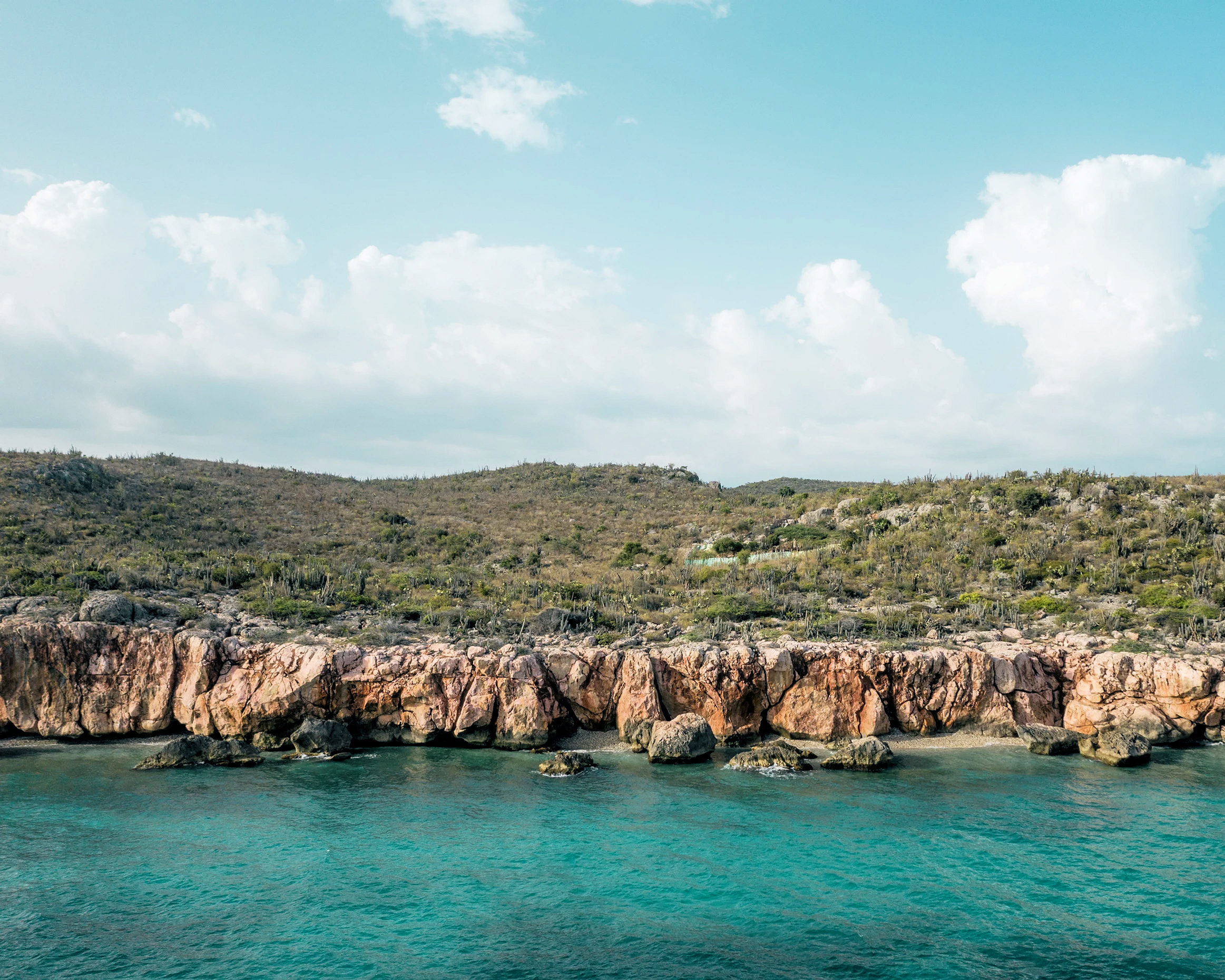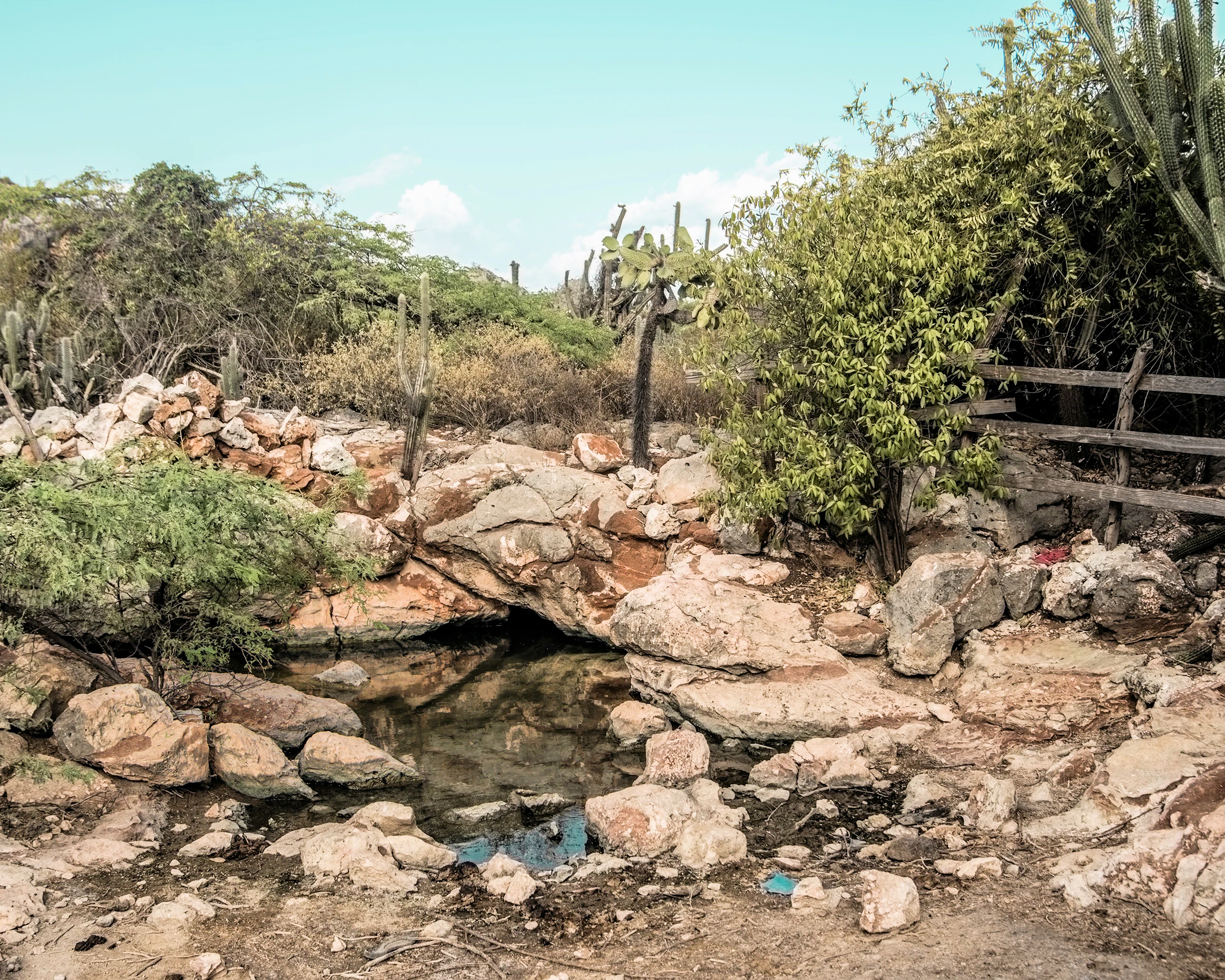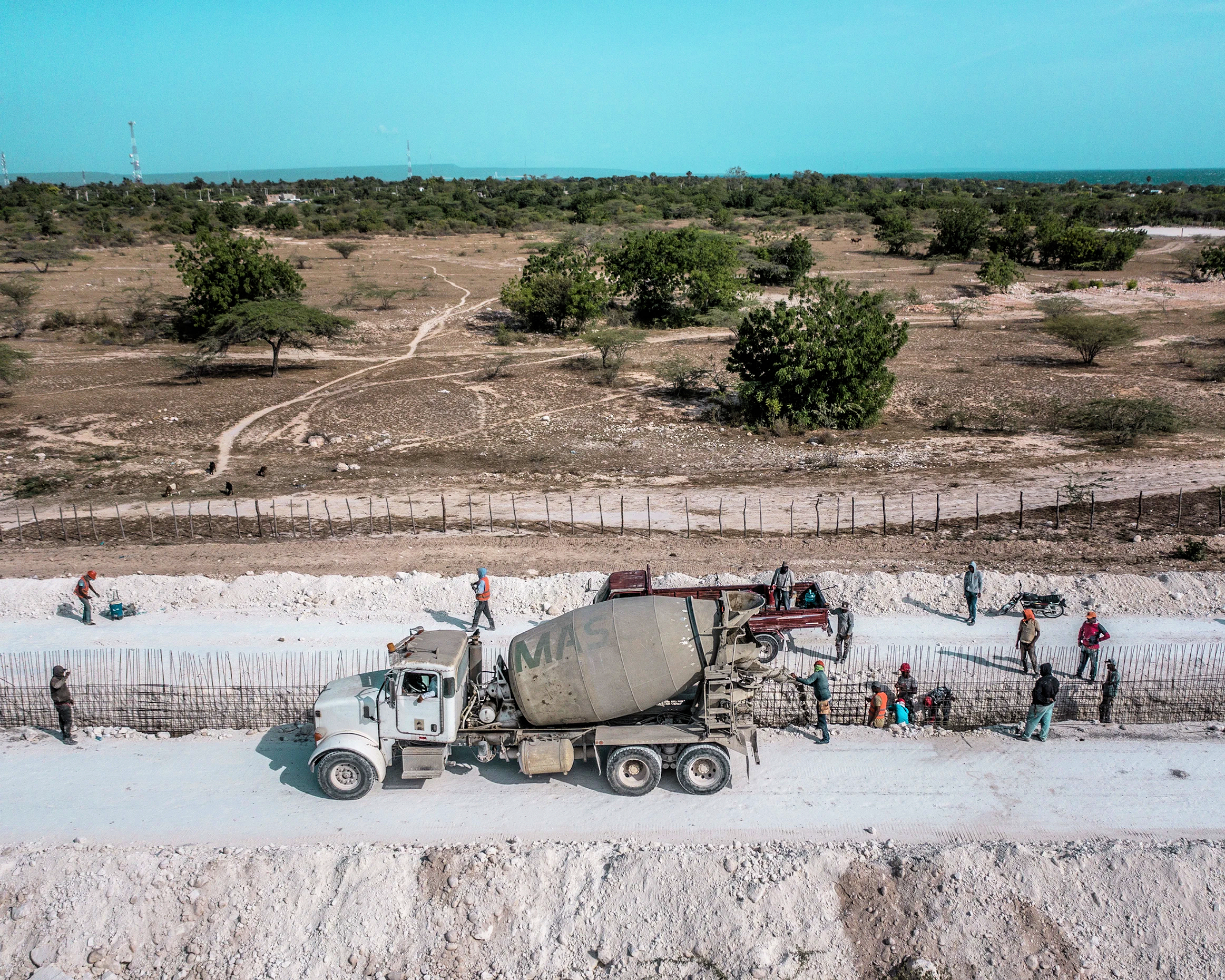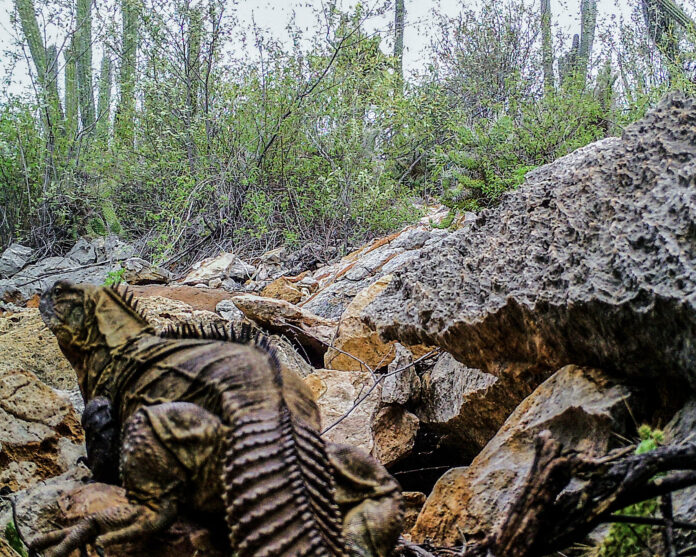The Cacique Henri Communal Nature Park is located on Haiti’s southern border with the Dominican Republic. This 35 square kilometer area, between Anse-à-Pitres (Haiti) and Pedernales (Dominican Republic), was declared a protected area by order of the municipal authorities in March 2014 due to its importance for biodiversity. It is home to the cyclura cornuta (rhinoceros iguana) and cyclura ricordi (ricord’s iguana).
“One is known locally as the ‘leza rikò’ or ‘leza miske,’” says René Jeune, wearing a yellow T-shirt, faded blue jeans, and a pink suitcase on his back. “The other is called ‘leza akòn.’”
Jeune is a field technician who serves as our guide to “Kase Dan” [Break Your Teeth] a locality in Anse-à-Pitres, where part of Cacique Henri Park is located.
“They come out this way when the eggs have hatched underground. You can see five or six lizards emerge from the hole at the same time,” he says as he shows us, using a wooden perch in an ancient niche for these species, made up of a myriad of small intertwined tree branches.
This scene may soon be a thing of the past. The rhinoceros iguana and the ricord iguana, two species endemic to Quisqueya Island, are threatened in Haiti. They are among the nine iguana species surveyed worldwide in 2017 by the International Iguana Foundation.

“This is the fruit they eat. This is the inner part they eat. Inside, there are countless little seeds,” René tells us, as he cuts the fruit into pieces. “There’s a big iguana that’s been here. You can see the width of the trace left by the tail. It passed through here, then it seems to be heading back towards this area,” he points, trying to retrace the trajectory.
This member of the volunteer conservation team at the Cacique Henri Communal Nature Park is passionate about iguana movements. His phone and special yellow marker help him immortalize the moments they consider unique. “The fact that iguanas are a bit rare, when you find the trace of a tail that big, which you don’t find easily, you’re obliged to mark the spot so you can remember exactly where you’d found it,” René says.
The Anse-à-Pitres dry forest, a natural treasure
The Parc Communal Cacique Henri is one of Haiti’s dry forests. However, in this area, deforestation is the law, leaving a washed-out, weakened, and terrifying landscape in its wake. “Since the colony [of Saint-Domingue], the area has always been a dry forest. In these types of spaces, there’s a biological biodiversity that’s unique to them. This habitat has other species of animals, plants, and caves that are quite interesting. They all play an important role in the environment. Because it’s a dry forest, it shouldn’t be neglected,” stresses Jean-Marry Exantus, a doctor in tropical ecology. According to him, several other species of animal and plant, globally threatened in the country, can be found there.
“There’s a palm tree I observed in Anse-à-Pitres. There are endemic birds considered threatened that we observe in the dry forest. This kind of attention would be very useful. These are our riches. What we have in the way of endemic species adds value to us, presenting the country in a different way on a global scale,” he stresses.
In recent years, the Park has found itself in the spotlight. Naturalists, working in conjunction with organizations in the Dominican Republic, have carried out studies on the forest. Also, the Fondation Connaissance et Liberté (FOKAL) has entered into a scientific collaboration with the NGO Caribaea Initiative – an international nature conservation organization working throughout the Caribbean – to work on the biodiversity axis. All this work has highlighted the presence of two endemic iguanas in this dry forest and the need to protect them.
As part of the scientific work undertaken in the Anse-à-Pitres forest, particular attention is being paid to the iguanas. This involves installing surveillance cameras, monitoring iguana populations, and locating their nests. “It’s true that iguanas are the focus of all this attention, but field visits to Anse-à-Pitres have shown me that there is a (significant) quantity of other species, endemic birds, other amphibian species, caves, crabs called soldier crabs and cave crabs found in the forest,” says Dr. Exantus.
In addition to visits related to ecology and biodiversity, the forest is frequented for religious and cultural reasons. There is a so-called mystical tomb and a cross in the area, said to have been installed by Freemasons for meditation practices, not to mention people who go down into the caves to sleep, and farmers who use the forest for free-range livestock farming.
A Damocles sword hanging over the heads of these reptiles?
A few kilometers from Parc Cacique Henri, in downtown Anse-à-Pitres, little schoolchildren gaze at the iron sculpture of a giant lizard on display in the sales area of Berthony Chéry, the town’s sculptor. It’s a little open-air shop on the side of the road. Flowers, animals and even hand-crafted human faces in cut iron are all on display.
“I consider the lizard a historical monument. It should represent the commune of Anse-à-Pitres. Everywhere. But some people don’t see it the way I do. On the contrary, they kill them to eat them. While I’m building, they’re destroying”, complains the sculptor. “I shouldn’t be crossing the border into the Dominican Republic with a work like this. A gentleman just approached me. We’re in the middle of negotiations. I’m going to give it to him to pass on to the other side. Over there, it might be better appreciated,” Berthony points out sadly.
While the sculptor uses the image of the lizards as a source of inspiration for his work, other residents of Anse-à-Pitre hunt them. On site, we met Raoul, a former lizard poacher. In our presence, he designed a trap to catch lizards in the rocky outcrop. It was a truly well-crafted demonstration. A rope noose set in a flat rock is placed over a hole. The aim is to capture them, whatever the cost. “It’s an animal that interests me a lot,” the poacher says. “We recover it. We experiment with it. We kill it and eat it. I can’t count the number of lizards that I’ve caught in traps. Sometimes I kill as many as five lizards a day. We can catch them with rope nooses, and other times we use trained dogs to hunt them.”

According to Raoul, this activity serves as a livelihood for some people. “A single recovered lizard can be worth 2,000 to 2,500 gourdes [$15-$19 US]. If the person can make money in this business, he takes pleasure in doing it. But I’m not looking for pleasure in such an initiative,” confides Raoul. One of the unjustified reasons given by poachers for hunting lizards is that the iguanas eat baby goats. They then present themselves as the regulators of this phenomenon.
Excessive deforestation is the other problem facing the dry forest housing Kase Dan Park. During our visit, we noticed the site of a large burning pit where a few months ago charcoal [charbon] was being produced for sale. “The cutting down of trees in Parc Cacique Henri has a big impact on the lizards, or at least what we call iguanas. The reason is simple: the charcoal producers cut down so many trees. These are trees that give seeds that the lizards eat,” pointed out field agent René Jeune.
Between poaching and the Dominican wall, Haiti’s iguanas are threatened
For university professor Jean-Marry Exantus, the rhinoceros and ricord iguanas living in Haiti are in real danger. “Ours are threatened, unlike those in the Dominican Republic, where you can walk down the streets and see them frequenting the area. In Haiti, the threats are enormous, even though these species are not found in the other types of forest we have in Haiti,” he points out, reminding us that when it comes to biodiversity, every animal or plant species counts. The importance becomes all the more precious when it comes to endemic species. “Tourists come from far and wide to observe these species. If they become extinct, they won’t be found anywhere,” says Exantus.
So as not to reach that red line, a children’s play area has been created in the private Sadhana Forest Park, also in Anse-à-Pitres. “While the children are playing, we can teach them how to love the environment, encourage them to plant trees, how to love and not chase animals out of the space,” explains Nixon Casséus, a member of the Parc Sadhana Forest team.
After fencing off the space, two lizards returned, he tells us. “When they started coming, they felt comfortable because we don’t hunt them. We don’t allow anyone to hunt them, or even throw stones at them. So they start to feel at ease in the space. They come and stay. Where they are, they start to reproduce. They feel at home,” explains Casséus.
On his cell phone, the manager shows us a photo of a giant lizard taking a drink of water. “This is the first big lizard we had. It gave birth to young,” he adds, showing us the habitats of the first two large lizards to occupy the space. “As soon as the lizards come out to go to the other side, people might pick them up and eat them. But we teach people about the importance of lizards in the environment,” he says. It’s in the name of this teaching that the children’s area was designed. “That’s our philosophy. When you teach a child, they can grow up with the same philosophy. It’s easier to teach a child not to do something than it is for an adult who already has it in their blood to want to kill the beast,” says Casséus.
The Dominican wall is a real danger for lizards
Since February 2022, the Dominican Republic has been building a wall no less than 160 km long along its border with Haiti. According to Dominican President Luis Abinader, the controversial project is designed to “control illegal immigration and crime.” The work will cost $31 million US. Part of the construction work is progressing apace on the Anse-à-Pitres border with the neighboring republic. The reinforced concrete wall, to which a metal structure will be attached, will be 3.90 meters high and 20 centimeters thick. It will be manned by the army and 70 surveillance and control towers. And this wall is not without consequences for the lives of endangered species.
We’ve traveled deep into the dry forest, with some guides more perceptive than others. Here in Maletchipe, the landscape is desolate, the deforestation palpable. “Between 2022 and 2023, in this area, there was a lot of vegetation. There were lots of iguanas. We had done some research to find out if they didn’t pass through there on their way to the Dominican Republic. The Dominicans built a wall on their side of the border, cutting off total access… cutting off any possibility of the lizards getting out of here to go over there,” says field agent René Jeune.

Pierre Michel Jean/ EA
The wall makes it impossible for lizards to come and go from one side of the island to the other. There are species found all over the island whose populations are dwindling in Haiti, whereas they are found in significant numbers in the Dominican Republic. With the wall’s completion, the situation is likely to worsen, according to several of the stakeholders interviewed. “There will be strong pressure on the lizard population on the Haitian side. After a certain number of years, we predict that these species may become extinct on the Haitian side, but we’ll be able to find them on the other side,” suggests Exantus. “Since it’s a border, if you leave Anse-à-Pitres and go over there, you’ll see that it’s the continuity of the dry forest. You’ll find species that leave Haiti for the Dominican Republic. And vice versa,” he adds.
The wall will stop these kinds of movements taking place on the ground. “After years, there will be a level of genetic differentiation between the Haitian and Dominican populations. There will be no interaction between the two sub-populations,” warns Professor Exantus, pointing out that the Dominicans are making progress in biological conservation.
According to him, an assessment of the species shared between the two countries will show that the situation is more critical in Haiti than in the Dominican Republic. “You’ll find two sub-populations. The information will tell you that the population is more numerous in the Dominican Republic than in Haiti, and that the threats are less in the Dominican Republic than in Haiti,” warns the doctor in tropical ecology, stressing that an awakening must be made on the Haitian side to save its biological heritage.
With the wall still under construction, the habit of over-hunting and systematically destroying these two species of lizards could lead to their disappearance, stresses the expert. “Yes, it can happen. It’s happened before. There are species that were on the whole island. As we speak, the quantity of this one found in Haiti is less than those found in the Dominican Republic, even though these species were distributed throughout the territory. This has happened in birds and a whole range of species,” Exantus explains.
It should be noted that, in addition to hunting, free-range farming – the eggs that people eat – prevents the species from multiplying. Fodder production, relocation of animal herds, forest guards, alternative means of survival for local populations, training people to guide tourists in the field, activities to reduce the pressure on local populations, and education to ensure that people do not see these animals as enemies: these are just some of the recommendations made by the expert. He believes that it is urgent that to set up projects to support farmers.
An earlier version of this article was first published on the website of Enquet’Action












